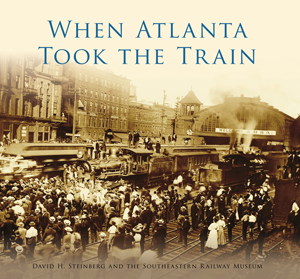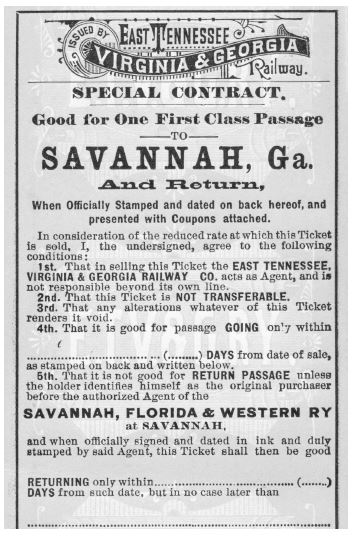A Homage To The Fallen Railroad Stations Of Atlanta
March 17, 2018, was the 100th anniversary of Peachtree Station, currently the only passenger railroad station serving Atlanta, Georgia. For many years, however, Atlanta was a hub for passenger rail service, just as it is now a hub for the airlines. Beginning in 1853, Atlanta was served by six passenger stations and countless passenger trains. Now only Peachtree Station and one passenger train survive. Many people still love the passenger train and are nostalgic for its golden years. As part of the broad history of railroading and in their own right, Atlanta’s passenger stations and trains deserve to be remembered.
The history of Atlanta’s passenger rail stations from pre-Civil War days to the present is told for the first time in a new book from Arcadia Publishing, “When Atlanta Took the Train”. Railroad historian David Steinberg wrote the book in collaboration with the staff of the Southeastern Railway Museum, which has been in operation for over 45 years and is the official transportation history museum of the State of Georgia. Join us now for a look back in time at Atlanta’s fallen railroad stations, with this book serving as our guide.

"When Atlanta Took the Train" beautifully preserves the romance of train travel and the history of Atlanta's passenger trains. The book includes an informative text documenting the passenger trains, railroads, and stations that served Atlanta over the years. It also includes many images of trains, stations, tracks, railroad workers, and passengers. It also shows the changing city of Atlanta with its streets, buildings, industries, and people over the years. This pictorial history of Atlanta’s railroads was a delight to read.
Atlanta’s most beloved passenger train was the Nancy Hanks, shown here in a 1970 photo. The Nancy Hanks was a local train which for years allowed students and residents from small Georgia towns easy transport to Atlanta or Savannah. Service on the Nancy Hanks was discontinued on April 30, 1971.
Even before the Civil War, Atlanta was a railroad hub and was served by Union Station, built in 1853. This station is famous because it was destroyed by General Sherman when he captured Atlanta in 1864. It is fascinating to see historical images from another era of the 1853 Union Station.
This early image shows the 1853 Union Station in its years of activity before its destruction during the Civil War.
After the Civil War, Atlanta slowly, but surely recovered. In 1871, the city became the home of another Union Station, Union Depot. With Atlanta’s rapid increase in population, Union Depot had become outmoded and obsolete by the turn of the century. However, it continued to offer passenger service until it was destroyed in 1930.
This image captures the 1871 station, its trains, and a large, lively crowd on a day in 1893.
A small passenger station called the East Tennessee, Virginia, & Georgia Depot served Atlanta from 1884 to 1895 but no known images of it remain. Fortunately, this book preserves the memory of the station and some of its associated artifacts.

A ticket sold on the East Tennessee, Virginia, and Georgia Railway for round-trip travel to Savannah.
In 1905, Atlanta received a large, magnificent railroad station with the opening of Terminal Station, designed by a young, gifted architect P. Thornton Mayre. Terminal Station served Atlanta until 1970 and was later destroyed in 1972.
This image captures the grandeur and beauty of Terminal Station during its glory years.
This schedule shows the 65 trains serving Terminal Station as of September 18, 1948. The station was busy, but service had already decreased substantially from its peak years. Passenger rail service would soon decrease even more dramatically.
In 1930, Atlanta welcomed its third Union Station. Located blocks away from Terminal Station, Union Station saw its last passenger train in 1971 and then was destroyed.
This 1966 image captures the beauty of Atlanta’s third Union Station only five years before its destruction.
The final station discussed in the book, and the only passenger station still operating in Atlanta is the Peachtree Station, which opened in 1918 in an Atlanta suburb which was fashionable at the time. Peachtree Station is home to Atlanta’s only surviving passenger train, the Crescent, which stops in Atlanta en route from New York City and Washington, D.C. to New Orleans and back. Peachtree Station has a place in my heart because I take the Crescent to Atlanta on trips to see my grandchildren. I know the platform, the long stairs leading to the terminal, the benches in the old waiting room, and the cabs awaiting the occasional passenger. With my lifelong love of trains I was glad to revisit Peachtree Station and its predecessors in this book.
This 1974 photograph captures Peachtree Station much as it is today, although the years have taken their inevitable toll.
We hope you have enjoyed this brief journey through time to Atlanta and its passenger railroad stations. Readers with a passion for railroading or with an interest in Atlanta will enjoy “When Atlanta Took the Train”.

